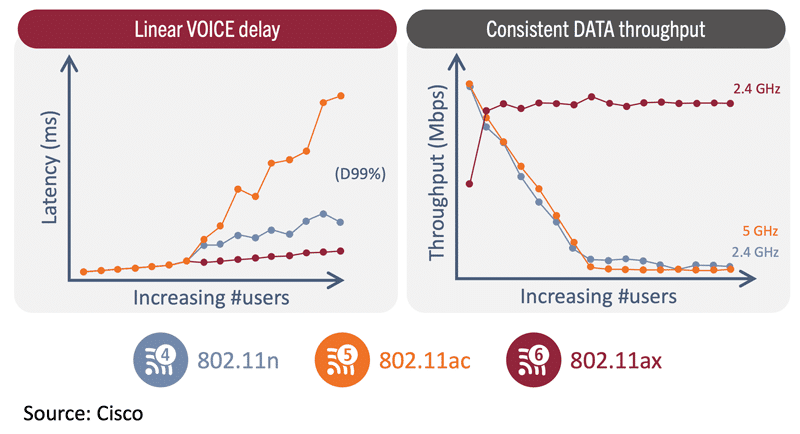White Paper Excerpt
Wi-Fi 6 – A Paradigm Shift in Connectivity

During the past couple of years, the Wi-Fi industry has been blessed with a series of extraordinary developments. Firstly, a new and vastly improved Wi-Fi standard (Wi-Fi 6) has been introduced into the world. Secondly – and perhaps even more importantly – a large or, depending on the country, a vast swath of new spectrum has been allocated to unlicensed use. Each on its own such developments would likely produce surges in growth and innovation, as well as torrents of new business opportunities. But the timely confluence of the two leads us to believe that the next few years will be characterized by an even more radical transformation: something akin to a paradigm shift in connectivity.
This means that Wi-Fi performance – including capacities, data rates, latency, and more – as well as Wi-Fi’s ubiquity and already broad applicability is likely to expand by orders of magnitude. Wi-Fi has grown to dominate the indoor wireless space in the past twenty years regardless of whether you measure market presence by traffic volumes, number of devices, or number of coverage locations. The coming decade will see an unprecedented expansion of Wi-Fi’s dominant position as well as a slew of new applications. Both will be driven by an abundance of new spectrum as well as powerful – and highly affordable – new Wi-Fi technology.
Wi-Fi in the 5G era – White Paper
This is an excerpt from our white paper Wi-Fi in the 5G Era – Strategy Guide for Operators. The full white paper is available here if you like what you read. Don’t hesitate to contact us if you have any questions.

A New Kind of Performance Boost: Wi-Fi 6
For the first time in wireless technology history, Wi-Fi will be capable of delivering a quality of service on par with that of cellular networks.
Wi-Fi 6 is the newest generation of certified Wi-Fi™ technology. Wi-Fi 6 is the most comprehensive and expansive reengineering of a Wi-Fi standard by a wide margin. Wi-Fi 6 comprises so many new features and performance boost that we have thus far only scraped the surface of what this new connectivity standard in time could bring to market in terms of innovative new use cases and improvements on existing applications.

Wi-Fi 6 (802.11ax) delivers a consistent and linear voice delay when the number of users increases, making it ideal for applications such as voice over Wi-Fi, real-time video conferencing, and more. While data rates of previous Wi-Fi standards quickly deteriorate as a function of number of users or devices, Wi-Fi 6 delivers consistent data throughput.
The most crucial Wi-Fi 6 feature is Orthogonal Frequency Division Multiple Access (OFDMA), which includes cellular-style scheduling. What in the past has been somewhat of an Achille’s Heel for Wi-Fi – meaning the rapid deterioration of data rates and latency as the number of connected devices increases – will soon be a thing of the past. OFDMA and scheduling bring deterministic performance to Wi-Fi for the first time, which means that Wi-Fi services (for example, those provided by CSPs) can be designed and deployed to comply with SLAs.
Previous Wi-Fi versions were more like a cocktail party. If you talk over each other, the polite thing is to shut up and try again when the air is free. Wi-Fi 6 with its OFDMA is more like a choir where the conductor decides who can sing and when.

OFDMA also offers multiple other benefits: Wi-Fi 6 Access Points can serve many more devices and delivers up to four times the data transmission capacity of previous generation systems. Another benefit is the ability of Wi-Fi 6 to extend the range of Wi-Fi services at low data rates rendering it very useful for IoT.
Wi-Fi 6 comprises a long list of other valuable features and functions, including UL (uplink) MU-MIMO, 160 MHz channels,1024QAM modulation, and more. Altogether the Wi-Fi 6 standard is designed to deliver a giant leap forward in high-density connectivity performance and not least in performance quality. This means Wi-Fi service providers will be able to provide a vastly improved Quality of Experience (QoE) to consumers and professional users at venues such as transportation hubs, stadiums, and malls, as well as for the ‘carpeted enterprise,’ hospitality, and MDUs.
In short, everywhere people congregate, Wi-Fi will be there – and Wi-Fi 6 will make the service much, much better.
Last but not least: There is no doubt that Wi-Fi 6 will also deliver enormous value within the home and – for example – for industrial applications.



